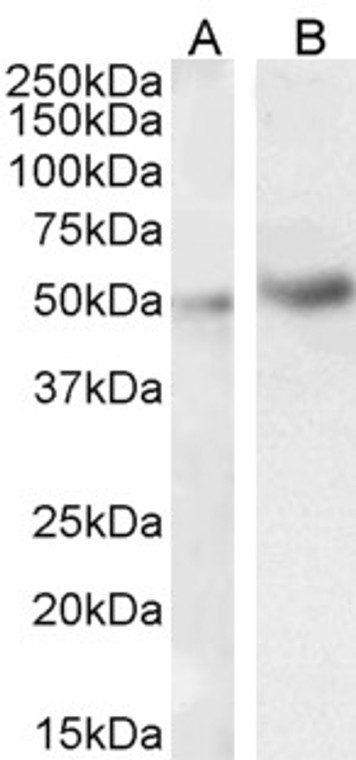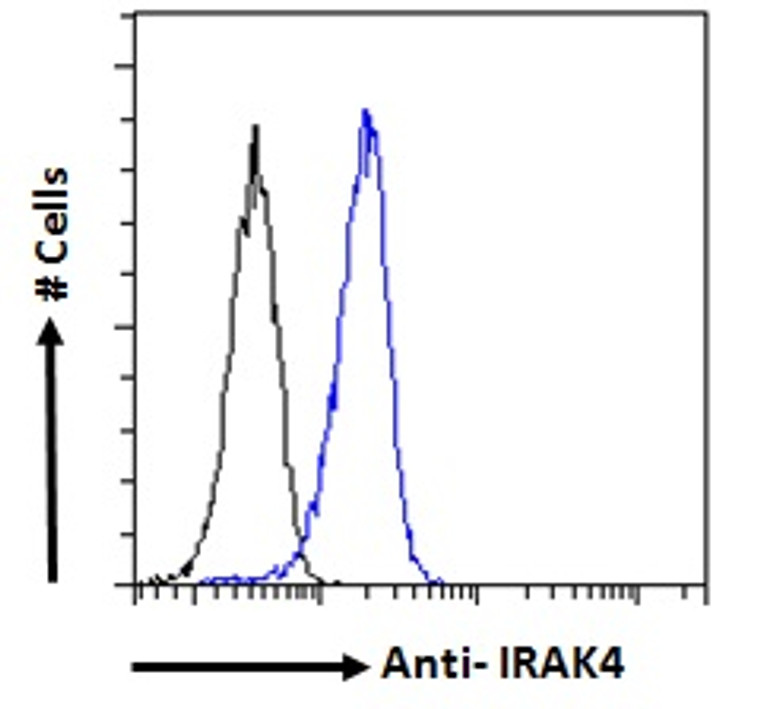| Host: |
Goat |
| Applications: |
Pep-ELISA/WB/IHC/IF/FC |
| Reactivity: |
Human/Mouse |
| Note: |
STRICTLY FOR FURTHER SCIENTIFIC RESEARCH USE ONLY (RUO). MUST NOT TO BE USED IN DIAGNOSTIC OR THERAPEUTIC APPLICATIONS. |
| Short Description: |
Goat polyclonal antibody anti-IRAK4 (N-Term) is suitable for use in ELISA, Western Blot, Immunohistochemistry, Immunofluorescence and Flow Cytometry research applications. |
| Clonality: |
Polyclonal |
| Conjugation: |
Unconjugated |
| Isotype: |
IgG |
| Formulation: |
0.5 mg/ml in Tris saline, 0.02% sodium azide, pH7.3 with 0.5% bovine serum albumin. NA |
| Purification: |
Purified from goat serum by ammonium sulphate precipitation followed by antigen affinity chromatography using the immunizing peptide. |
| Concentration: |
0.5 mg/mL |
| Dilution Range: |
IHC-3.75µg/mlIF-Strong expression of the protein seen in the cytoplasm and microtubules of HeLa cells. 10µg/mlELISA-antibody detection limit dilution 1:32000. |
| Storage Instruction: |
Store at-20°C on receipt and minimise freeze-thaw cycles. |
| Gene Symbol: |
IRAK4 |
| Gene ID: |
51135 |
| Uniprot ID: |
IRAK4_HUMAN |
| Immunogen Region: |
N-Term |
| Accession Number: |
NP_057207.2; NP_001107654.1 |
| Immunogen Sequence: |
NKPITPSTYVRC |
| Function | Serine/threonine-protein kinase that plays a critical role in initiating innate immune response against foreign pathogens. Involved in Toll-like receptor (TLR) and IL-1R signaling pathways. Is rapidly recruited by MYD88 to the receptor-signaling complex upon TLR activation to form the Myddosome together with IRAK2. Phosphorylates initially IRAK1, thus stimulating the kinase activity and intensive autophosphorylation of IRAK1. Phosphorylates E3 ubiquitin ligases Pellino proteins (PELI1, PELI2 and PELI3) to promote pellino-mediated polyubiquitination of IRAK1. Then, the ubiquitin-binding domain of IKBKG/NEMO binds to polyubiquitinated IRAK1 bringing together the IRAK1-MAP3K7/TAK1-TRAF6 complex and the NEMO-IKKA-IKKB complex. In turn, MAP3K7/TAK1 activates IKKs (CHUK/IKKA and IKBKB/IKKB) leading to NF-kappa-B nuclear translocation and activation. Alternatively, phosphorylates TIRAP to promote its ubiquitination and subsequent degradation. Phosphorylates NCF1 and regulates NADPH oxidase activation after LPS stimulation suggesting a similar mechanism during microbial infections. |
| Protein Name | Interleukin-1 Receptor-Associated Kinase 4Irak-4Renal Carcinoma Antigen Ny-Ren-64 |
| Database Links | Reactome: R-HSA-1257604Reactome: R-HSA-166058Reactome: R-HSA-5603037Reactome: R-HSA-5603041Reactome: R-HSA-6811558Reactome: R-HSA-9020702Reactome: R-HSA-975110Reactome: R-HSA-975138Reactome: R-HSA-975155Reactome: R-HSA-975871 |
| Cellular Localisation | Cytoplasm |
| Alternative Antibody Names | Anti-Interleukin-1 Receptor-Associated Kinase 4 antibodyAnti-Irak-4 antibodyAnti-Renal Carcinoma Antigen Ny-Ren-64 antibodyAnti-IRAK4 antibody |
Information sourced from Uniprot.org
12 months for antibodies. 6 months for ELISA Kits. Please see website T&Cs for further guidance









